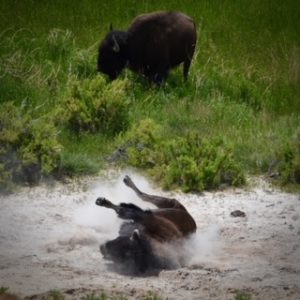By Charlie Brandin
The great debate – bison or buffalo?
I spent last weekend at the Wind River Indian Reservation learning how western science (which classifies the animal as bison) and indigenous knowledge (which classifies it as buffalo) come together for an incredible conservation effort to bring buffalo back to native lands!

The livelihoods of many tribes were centered around the buffalo, which are still culturally important today.
The last buffalo to set hoof on the Wind River Indian Reservation was in 1885, 55 years after the US Army started a campaign to wipe out the buffalo population to take control over Native Americans.
In the 1700’s there were 30 to 60 million buffalo in the wild. However, by 1884 there were only an estimated 325 buffalo left. This near extinction of buffalo devastated Native Americans, especially the Northern Arapaho and Eastern Shoshone, who now call the Wind River Reservation their home.
Most native tribes are categorized by what their main food source is: for example, “sheep-eaters,” “salmon-eaters,” or for the Northern Arapaho and Eastern Shoshone, the “buffalo-eaters.” For these tribes, their entire life and culture were centered around the buffalo which was used for food, shelter, and ceremonial purposes. All parts of the animal were used, from nose to tail. Not only is the buffalo itself important, but the spirit of the buffalo is also highly present in their daily lives. One example of the spiritual connection can be shown in sweat lodges, which are made with 28 poles, the same amount of ribs on a buffalo.
Today, the Eastern Shoshone and Northern Arapaho tribes (with the help of the National Wildlife Federation) are successfully housing around 130 buffalo on land which they had to buy back, but were originally promised during the Fort Bridger Treaty in 1863. Jason Baldes, the Tribal Buffalo Coordinator, and the National Wildlife Federation are hoping to expand the land and change priorities from cattle grazing to buffalo habitat in and around the reservation.

Did you know that Buffalo “wallowing” benefits more species than just the buffalo?
Making a switch from cattle grazing to buffalo habitat would not only help the native people connect with their culture but would also help the ecosystem. Buffalo like to give themselves dust baths by rolling in the dirt, also called wallowing, which has many purposes, including cooling off and helping shed their coats. The leftover wallows are important for water accumulation and seed dispersal and are incredibly helpful for plant diversity. Wallowing is also beneficial to birds because they can use the buffalo coats that have been shed to build nests.
The National Wildlife Federation’s Tribal Partnerships Program aims to restore the way of life for Native American groups all over the United States by returning buffalo to their land. Restoring buffalo habitat on native lands will help tribes reconnect with their historical way of life and will provide a sustainable food source, as well as restore ecosystems.
Learn more at https://www.nwf.org/Our-Work/Wildlife-Conservation/Bison/Tribal-Lands
